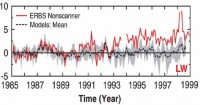By Dr. Richard Lindzen, Alfred P. Sloan Professor of Meteorology, Department of Earth, Atmospheric and Planetary Science, MIT on Watts Up With That
The basic idea is that the atmosphere is roughly transparent to visible light, but, due to the presence of greenhouse substances like water vapor, clouds, and (to a much lesser extent) CO2 (which all absorb heat radiation, and hence inhibit the cooling emission), the earth is warmer than it would be in the absence of such gases.
If water vapor and clouds respond to the increase in temperature in such a manner as to further enhance the cooling inhibition then we have what is called a positive feedback, and the temperature needed to reestablish equilibrium will be increased. In the climate GCMs (General Circulation Models) referred to by the IPCC (the UN’s Intergovernmental Panel on Climate Change), this new temperature ranges from roughly 1.5C to 5C. The equilibrium response to a doubling of CO2 (including the effects of feedbacks) is commonly referred to as the climate sensitivity.
When temperature fluctuations lead to warmer temperatures, emitted heat radiation should increase, but positive feedbacks should inhibit these emissions by virtue of the enhanced ‘blanketing.’ Given the model climate sensitivities, this ‘blanketing’ should typically reduce the emissions by a factor of about 2 or 3 from what one would see in the absence of feedbacks. If the satellite data confirms the calculated emissions, then this would constitute solid evidence that the model feedbacks are correct.
Two Important Points: 1. Equilibration takes time, 2. The feedbacks are responses to temperature - not to CO2 increases per se. The time it takes depends primarily on the climate sensitivity, and the rapidity with which heat is transported down into the ocean. Both higher sensitivity and more rapid mixing lead to longer times. For the models referred to by the IPCC, this time is on the order of decades. This all leads to a crucial observational test of feedbacks!
The Results of an Inadvertent Test
From Wielicki, B.A., T. Wong, et al, 2002: Evidence for large decadal variability in the tropical mean radiative energy budget. Science, 295, 841-844.
Comparison of the observed broadband LW flux anomalies for the tropics with climate model simulations using observed SST records. The models are not given volcanic aerosols, so the should not expected to show the Mt. Pinatubo eruption effects in mid-1991 through mid-1993. The dashed line shows the mean of all five models, and the gray band shows the total rnage of model anomalies (maximum to minimum). Image below, larger here.

From 1985 until 1989 the models and observations are more or less the same - they have, in fact, been tuned to be so. However, with the warming after 1989, the observations characteristically exceed 7 times the model values. Recall that if the observations were only 2-3 times what the models produce, it would correspond to no feedback. What we see is much more than this - implying strong negative feedback. Note that the ups and downs of both the observations and the model (forced by observed sea surface temperature) follow the ups and downs of temperature (not shown). Note that these results were sufficiently surprising that they were confirmed by at least 4 other groups.
The authors did not dwell on the profound implications of these results - they had not intended a test of model feedbacks! Rather, they mostly emphasized that the differences had to arise from cloud behavior (a well acknowledged weakness of current models). However, as noted by Chou and Lindzen (2005, Comments on “Examination of the Decadal Tropical Mean ERBS Nonscanner Radiation Data for the Iris Hypothesis”, J. Climate, 18, 2123-2127), the results imply a strong negative feedback regardless of what one attributes this to.
The Bottom Line
The earth’s climate (in contrast to the climate in current climate GCMs) is dominated by a strong net negative feedback. Climate sensitivity is on the order of 0.3C, and such warming as may arise from increasing greenhouse gases will be indistinguishable from the fluctuations in climate that occur naturally from processes internal to the climate system itself.
Read full post and comments here.




